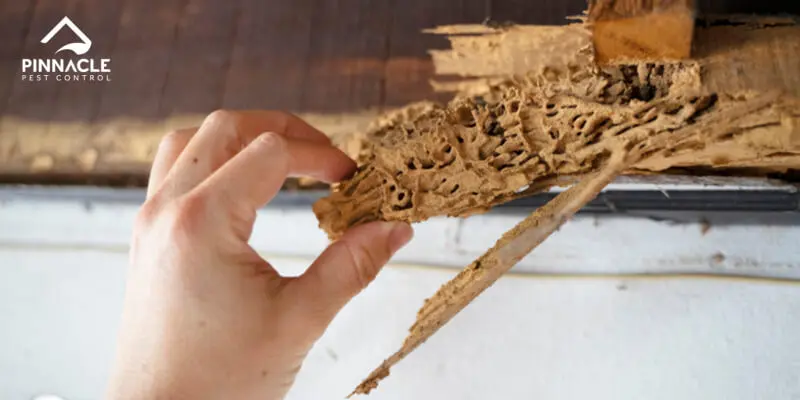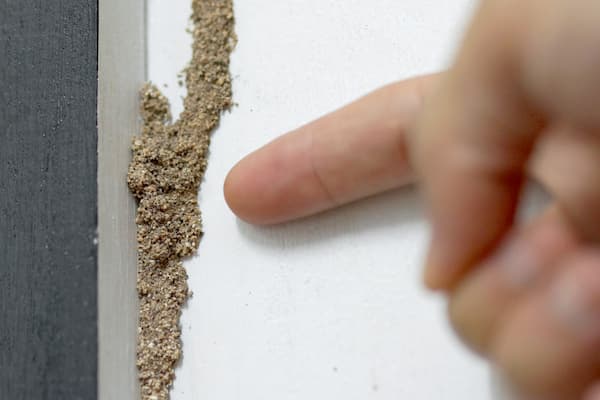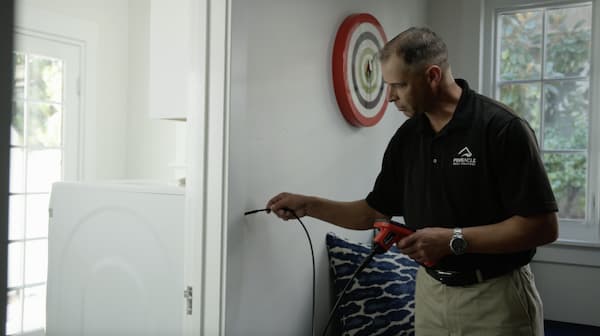Termites are silent pests that can infest your property without you knowing it until it’s too late. Prevent significant termite damage on your property by scheduling annual termite inspections with Pinnacle Pest Control.

During a termite infestation, termites can thrive off eating the wooden parts of your property’s structure. Over time, this can cause significant damage that can compromise your property’s structural integrity, which can require hundreds or thousands of dollars to have it repaired.
Worst of all, because of the silent effects that termites can have on your property, you won’t know that they’re there until you’re actively looking for signs of termite infestations.
Pinnacle Pest Control offers termite inspection services for residential and commercial properties in the Sacramento Metro and the East Bay Areas. With decades of experience and a professionally-trained team, we can spot the tiniest signs that suggest termite infestations and can conduct thorough termite inspection checks to ensure your property is termite-free.
Significant signs of termites include:

Since termites are habitual pests, our inspector will examine where wood is present on a home's exterior & interior areas, such as:

With our integrated pest management services, we offer more than just a comprehensive sweep of your home. In case we find signs of termites, we can offer our services to eliminate all termites on the property and keep your property termite-free.
If your home is free of termites, we can help you keep it that way by inspecting vulnerable entry points and features like water damage, dry-rot, plumbing leaks, and other minor issues that can attract termites or allow them to thrive if they enter your home.
Contact us today to schedule your initial inspection and see the difference Pinnacle Pest Control provides with top-quality pest control management.
It has never been easier to ensure you never have to deal with any kind of pest in your home again, when you call Pinnacle Pest Control. Our pest control professionals can make your home invaders a thing of the past. Book your appointment today.
Pinnacle Pest Control can perform a thorough visual inspection of your property. Our highly-skilled pest control technicians will check the outside and inside your home and can even go through crawl space, if available. We’ll examine your home from top to bottom for any signs of termites and then provide you with a full inspection report of your home.
If we find signs of a termite infestation, we can provide you with a termite inspection report of the infested areas, the severity of the termite damage, and an estimated quote of our services to treat your infestation. Our services include integrated pest management, which not only eliminates termites from your property but also consists of our recommendations on repairing vulnerable points and addressing practices that make your property attractive to termites.
If there are no signs of a termite infestation, our term also provides preventative measures. During our inspection, we also watch out for dry-rot, water damage, plumbing leaks, and any other factors that can affect your wood and make it susceptible to termite infestations.
We can recommend ways to best address these concerns and reduce the risk of attracting termites until your next termite inspection.
When left unchecked, termites can plague both residential and commercial properties and cause significant property damage. Unlike other insects and pests, it can be difficult for an everyday person to spot termite infestations until significant damage is done as termites can thrive within your walls away from humans’ sight.
That’s why when dealing with termites, it’s much better to be safe than sorry. By scheduling annual termite inspections, you can have professionals potentially spot the smallest signs of termite infestations and act accordingly. Even if your property doesn’t have termites, there’s no telling if or when they can arrive and cause devastating damage to your property. And with Pinnacle Pest Control, termite inspection services offer both inspections and additional steps to keep termites away from your property.
Termites can cause structural damage to a home when a colony feasts on your property’s frame. This can put anyone in your property – family, friends, tenants, employees, and customers alike – in danger. Termites can also have serious consequences for both homeowners and business owners.
Homeowners looking to rent out their properties and those looking to sell their property are required by Californian law to disclose their termite infestation, which can affect your real estate market value.
Business owners, on the other hand, can incur huge costs from the potential damage termites have to your property. There’s even a risk of injuries in the workplace because of damaged wooden fixtures.
Our team of pest control specialists is licensed, bonded, insured, and qualified, meaning all of our clients are in safe and capable hands when we do our job on your property. During termite inspections, our pest control technicians know the tiniest details to spot a termite infestation and can scour your home from top to bottom for any sign of them. By the end of inspections, you can be ensured that every report is reliable and accurate, while our recommendations can help you protect your property.
We’ve been operating since 1998, and our inspection services have kept residential and commercial properties free of termites. Since then, we’ve continuously strived for excellent customer service and results that satisfy our clients’ needs. We’re confident in our termite inspection services and, in case of an infestation, can provide effective termite treatment for your property. We guarantee that our treatment will leave your property free of termites. If termites return, we’ll be back at no charge to you.
No matter what kind of pest problem you’re dealing with, you can count on Pinnacle Pest Control to provide top-notch pest extermination services. With decades of experience under our name, we have already helped hundreds of residents and business owners in Sacramento eliminate pests in their property and keep them away for good.

A: Our technicians look for two things. First, they look for signs of termite activity in susceptible areas in your property. While everyday homeowners may be able to spot some of these signs, our technicians can spot the tiniest signs of infestation and know where to look. This can include mud tubes, wood damage, termite droppings, or even live termites. Termites can look similar to flying ants, and our technicians are capable of spotting the type of termite (such as subterranean termites, drywood termites, or dampwood termites) and can determine the best way to treat your infestation.
Second, our technicians also look for weak points in your property. Whether or not you have termites in your property, you may have fixtures that make it an attractive location that termites can thrive in. Things like easy entry points, high-moisture areas, dry-rot, water damage, and places where wood and soil come into contact can be vulnerable to termites. After inspections, our team can report these weak points and offer recommendations to fix, modify, or completely remove these weak points to prevent an infestation.
A: Ideally, all property owners should have their home or commercial establishment inspected at least once a year by a professional. Depending on the size of your property and its condition, it can take around 45 minutes up to one and a half hours to complete a thorough inspection.
A: At Pinnacle Pest, we use a number of eco-friendly ways to remove termites from your property. There are different types of termites such as subterranean termites, drywood termites, dampwood termites, and more, and these are best handled accordingly.
A: You could try to inspect your property on your own, but you may be putting yourself at a disadvantage and your property at risk. There are some small signs of infestations that not everyday homeowners can spot, and even then you may not know where to properly look. While there are DIY pest control products available, you may only be killing a handful of termites and not eliminating the much larger colony. Our technicians are professionally-trained to inspect, handle, and manage pest infestations, so you can expect better and more efficient results from skilled pest control services compared to DIY options.
Keep your property guarded against the silent threat of termite infestations with annual termite inspections from Pinnacle Pest Control. Rather than spotting a termite problem on top of significant property damage, our inspection services can spot both infestations and vulnerable areas in your home before termites can further degrade your property’s condition. Contact us today to schedule your annual termite inspection and receive a comprehensive report for your property’s safety.
It has never been easier to ensure you never have to deal with any kind of pest in your home again, when you call Pinnacle Pest Control. Our pest control professionals can make your home invaders a thing of the past. Book your appointment today.